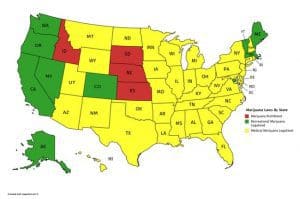
Marijuana legality by state. Key: red, pot is illegal; green, recreational pot is legal but regulated; yellow, medically-prescribed marijuana is legal (map credit: inverse.com)
Our northern neighbor Canada has just gone to pot. The US will likely be heading further in that direction on Tuesday, Nov. 6th.
Yahoo reports that
“Three states — Michigan, Utah and Oklahoma — will hold referendums in 2018 on the legalization of marijuana for recreational and medical use, continuing a nationwide trend of acceptance of the drug….In a January poll, the Pew Research Center found that roughly six in 10 Americans (61 percent) think cannabis should be legalized for recreational use by adults. With this change of perspective came a series of changes to state laws. Colorado and Washington became the first states to legalize marijuana for recreational use in 2012; seven states and Washington, D.C., followed their lead. In addition, marijuana has been legally approved for medicinal use in 29 states, and it’s been decriminalized (though not legalized) in 13.”
We argue that the use of marijuana on a recreational basis is a serious health issue — requiring discouragement and rehabilitation — but that its production, distribution, and consumption should nevertheless be fully legalized. That would go much further than either Canada or any US state has thus far contemplated.
Why are we recommending such a seemly contradictory policy, you may ask — of fully legalizing but strongly discouraging use?
Why marijuana use needs to be discouraged
Marijuana isn’t harmless, contrary to what its advocates in NORML and elsewhere would have one believe. Its use needs to be discouraged both because of its adverse consequences for society and for the individuals consuming it.
Increased traffic accidents
Traffic accidents are increasing in the states that have legalized recreational marijuana use, small-scale possession, and home production. BloombergQuint reports that
“The Insurance Institute for Highway Safety found, in a study to be released on Thursday, that traffic accidents are rising in states that have legalized recreational marijuana. That followed stark warnings from the National Transportation Safety Board, which on Tuesday issued several recommendations to combat drug-impaired driving….A separate IIHS study saw a 5 percent increase in the rate of crashes per million vehicle registrations reported to police in Colorado, Oregon and Washington versus neighbors that haven’t legalized the drug….The NTSB’s recommendations followed an investigation of a 2017 crash in rural Texas that killed 13 people. The accident was caused by a pickup truck driver who was high on marijuana and an anti-anxiety medication and slammed head-on into a church bus. Video shot by another driver showed the pickup repeatedly veering onto the shoulder and across the double-yellow line for 15 minutes….Drugs were detected in 30 percent of drivers who died in accidents in 2006 and were tested for drugs, according to the NTSB. That number jumped to 46 percent in 2015. In random roadside testing, more than 22 percent of drivers showed evidence of drug use, according to National Highway Traffic Safety Administration data.”
Damage to the teenage brain — and their posterity

Bad habits shared with peers
Here is an excerpt from a medical abstract published in July of this year:
“Marijuana is the most commonly used drug of abuse among adolescents. Considerable clinical evidence supports the hypothesis that adolescent neurodevelopmental exposure to high levels of the principal psychoactive component in marijuana, -delta-9-tetrahydrocanabinol (THC), is associated with a high risk of developing psychiatric diseases, such as schizophrenia later in life….Adolescence is a highly vulnerable period for the development of the brain, where the inhibitory GABAergic system plays a pivotal role in the maturation of regulatory control mechanisms in the central nervous system (CNS). Specifically, adolescent neurodevelopment represents a critical period wherein regulatory connectivity between higher-order cortical regions and sub-cortical emotional processing circuits such as the mesolimbic dopamine (DA) system is established. Emerging preclinical evidence demonstrates that adolescent exposure to THC selectively targets schizophrenia-related molecular and neuropharmacological signaling pathways in both cortical and sub-cortical regions, including the prefrontal cortex (PFC) and mesolimbic DA pathway, comprising the ventral tegmental area (VTA) and nucleus accumbens (NAc). Prefrontal cortical GABAergic hypofunction is a key feature of schizophrenia-like neuropsychopathology. This GABAergic hypofunction may lead to the loss of control of the PFC to regulate proper sub-cortical DA neurotransmission, thereby leading to schizophrenia-like symptoms.” (Source: Front Psychiatry. 2018 Jul 2;9:281, “Effects of Adolescent THC Exposure on the Prefrontal GABAergic System: Implications for Schizophrenia-Related Psychopathology,” PMID: 30013490″)
Other studies — connecting marijuana use in young people to decreased brain white matter, cognitive deficits, and increased risk of schizophrenia — are here, here, and here.
Judith Grisel, a professor of psychology and neuroscience at Bucknell University and a practicing neuroscientist, notes that
“More teenagers now smoke marijuana than smoke products with nicotine; between 30 and 40 percent of high school seniors report smoking pot in the past year, about 20 percent got high in the past month, and about 6 percent admit to using virtually every day. The potential consequences are unlikely to be rare or trivial.”
She reports that “…heavy-smoking teens…are 60 percent less likely to graduate from high school, and are at substantially increased risk for heroin addiction and alcoholism….[T]hey’re seven times more likely to attempt suicide” and that the young abusers may not only be cursing themselves but also their progeny:
“The offspring of partying adolescents, specifically those who used THC, may be at increased risk for mental illness and addiction as a result of changes to the epigenome — even if those children are years away from being conceived. The epigenome is a record of molecular imprints of potent experiences, including cannabis exposure, that lead to persistent changes in gene expression and behavior, even across generations. ”
Why marijuana needs to be legalized
Failure of the “War on Drugs”
But paradoxically, despite these harms, marijuana needs to be legalized. “No matter which side of the political spectrum you look, from NPR to NBC to Fox News, the consensus is that the war on drugs is failing,” an addiction treatment source reports.
The US is far and away the main consumer market for drugs in the Western hemisphere. As long as marijuana is still an illegal Schedule 1 drug as far as the US government is concerned, there will still be an economic incentive for criminal drug syndicates to organize the production and distribution of pot and other illegal drugs, whether from south of the border or in northern California.
Collateral damage to Latin America and the US

US-bound refugees crowded on a truck in in Guatemala City (Johan Ordonez/Getty Images)
The drug cartels and drug gangs feeding the illegal substance habit in the US — notably for marijuana and cocaine — have devastated the civil fabric of Mexico, several Central American countries, and several coca-growing countries in South America. The violence of the drug cartels and drug gangs in Central America in turn has produced huge waves of refugees marching northward seeking asylum in the US. Our drug habit that created their drug mafias bears principal responsibility for their exodus.
The sad truth is that full legalization and plentiful supply is the best way to get the drug cartels and gangs out of the narcotics business. But US states have to be careful they don’t tax and regulate the sale so onerously — as New York City has done with cigarettes and California with marijuana — that illegal production, distribution, and retailing can still thrive and undersell the legal farmers and outlets. Marijuana legalization should not be treated as a government cash cow but rather as a crime buster and liberty enhancer. Human desire, as we learned during Prohibition, is best handled by acquired self control rather than a perverse, counter-productive nanny state. Our prison population will also happily be reduced as a major category and incentive for crime disappears.
The hard part
There are already numerous ways that individuals can foolishly harm themselves — bad foods, bad company, smoking, alcoholism, bad sex, etc. Our proposal just fully legalizes something — pot consumption — that is already widely engaged in. This means that good prevention and rehabilitation programs will be essential. While marijuana doesn’t seem to be chemically addictive, it degrades cognition and nourishes psychological dependencies that may lead to experimenting with other substances — in particular, chemically additive drugs. We’d like to see the segment of the pharmaceutical industry concerned with pain management come up with cheaper, safer, more dose-consistent pain killers than smoked medical marijuana — which is already damaging enough to air passages.
Click here to go to the previous Founders Broadsheet (“Prosperity threatened by interest rates, oil, and trade wars”)

Leave a Reply